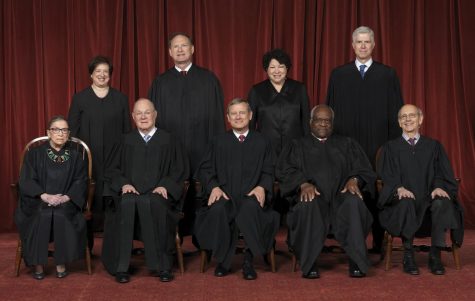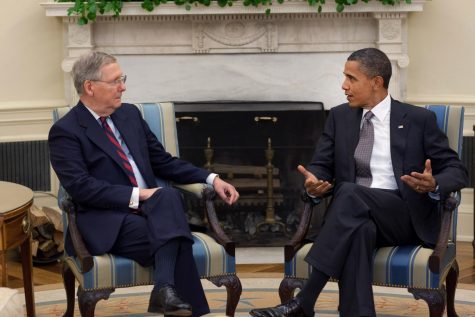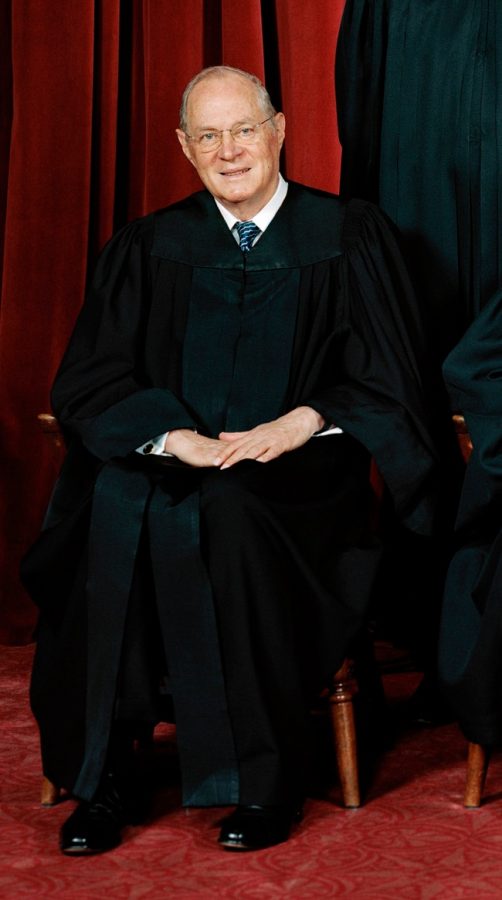Supreme Court Justice Anthony Kennedy: The drastic implications of his retirement and imminent replacement by President Trump
Igniting the political vitriol in Washington, Justice Anthony Kennedy’s unexpected retirement will dramatically alter the landscape of the traditionally less-partisan Supreme Court. An ensuing battle is expected over the unprecedented importance of his replacement.
July 6, 2018
Sending shockwaves throughout the nation, in a decision that could re-define American policy for the next several decades, Supreme Court Justice Anthony Kennedy, 81, announced he will retire July 31 after sitting on the bench for more than 30 years.
Kennedy has been largely depicted as the court’s “swing vote,” balanced between the four more predictable conservative justices and the four opposing liberal justices. During his tenure, he provided the deciding vote to break 4-4 ties in favor of the liberal justices on cases regarding same-sex marriage, right to an abortion and affirmative action. His vote also decided the cases for conservatives regarding limiting regulation on campaign finance, gun rights restrictions, voter restriction cases and deciding the 2000 Presidential election in favor of George W. Bush.
President Donald Trump now has the capability to cement a conservative majority on the court for the next generation.
To gather further insight, I sat down with College of DuPage Political Science Professor David Goldberg to discuss the ramifications of such a pivotal moment in American political history.
Joey Weslo: “How would you categorize Anthony Kennedy’s legacy for the Supreme Court and American politics?”
David Goldberg: “Kennedy is important because as a (Former President Ronald) Reagan appointee, he represents a change in the Supreme Court away from the court of Earl Warren, which was more activist, to one that was more conservative. What Kennedy has come to be known for is being the swing vote, however, in reality he has been a generally consistent conservative vote. At the same time, there have been key decisions in which he swung to be the deciding factor. With the court so divided as it has been for the past couple of decades, the fact that he has been a centrist conservative helped him solidify this legacy of the so-called swing vote. Two important votes come to my knowledge, the Obergefell v. Hodges (2015) vote on gay marriage, and Planned Parenthood v. Casey (1992), a Pennsylvania abortion case in which he struck down restrictions on abortion.”

JW: “Did President Reagan miscalculate Kennedy’s social liberal tendencies?”
DG: “No, I believe what happens is the thinking of justices on social and economic issues evolves over time. You see plenty of other justices put on the court by a conservative or a liberal president, who over the course of their time on the bench, evolve in their reasoning.”
JW: “Do you see any future evolution of the current conservative justices on the court into the now void swing vote role?”
DG: “Justice John Roberts is a conservative judicially, but he has proven to be a swing vote before, such as on the Affordable Care Act cases. Roberts’ thinking appears to have evolved a little more towards the center.”
JW: “Is there an ethical pressure on Roberts to play the role of the swing vote for the sake of the health of the court in maintaining balance and security?”
DG: “People have argued that some of the times Roberts has voted against the conservative majority is because he is lobbying to gain the liberal votes for another case sometime in the future.”
JW: “Are there any Republicans advocating for another ‘swing vote’ to maintain the current balance of the court? Would they try to promote future stability and fluidity of the court over partisanship?”
DG: “Some conservative writers have made that exact argument, saying they shouldn’t nominate a hardline conservative and the court functions best when both sides lose a little bit.”
JW: “Have there been any historical unbalanced majorities in the court’s past, whether towards the left or the right?”
DG: “Yes, but the court has historically been less partisan. For example, Justice Earl Warren was placed on the bench by the conservative President Dwight Eisenhower, and Warren’s was still considered a more activist court. Progression happened on civil rights and criminal defendant rights all under Earl Warren’s court. Looking back, the court was more activist or liberal, and then there was a conservative backlash against that. But the Court was looked less as left and right.”

JW: “Do you think there is a hyper-partisanship in the court now, or is that just the public’s perception of it, and it has remained the same old court?”
DG: “I do believe the Court is more divided than it has been in the past, but it is also a combination of reality and public perception. Public opinion has become more polarized, and so the public sees that when they look at the court. There is more nuance and subtlety to how justices like Roberts behave than just labeling them conservative or liberal.”
JW: “Was the move led by Senate Majority Leader Mitch McConnell (R-KY) not to even have a vote on President Barack Obama’s Supreme Court nominee, Merrick Garland, really as unprecedented as it was labeled? I know Justice Clarence Thomas’ nomination was upheld at first.”
DG: “Certainly from the mid-twentieth century forward it was absolutely unprecedented. Supreme Court nominations did not use to be as contentious as they are now.”
JW: “What divided the stability? Was it the rise of single-issue minded voters?”
DG: “For sure. I think the divisiveness of abortion plays an important role, as does executive power issues. Divisive social issues can drive the contention. Before 1973, abortion was not an issue. The case mobilized social conservative voters and pro-choice supporters in different ways. Even in times of great social upheaval like the 60’s and early 70’s, Supreme Court nominations weren’t as contentious. What happened with Clarence Thomas was normal. The Senate held hearings, the judiciary committee held confirmation hearings, and in the process for the hearings they uncovered the controversial information regarding the sexual harassment. There are other examples of presidential nominees to the court who were rejected or who withdrew their nomination because unfavourable information was uncovered along the way. Under McConnell, they didn’t even allow Merrick Garland to advance that far.”
JW: “Will there be any negative political repercussions for McConnell wanting to move the nomination through so quickly now, when during President Obama’s term, he tried every tactic to stall?”
DG: “It is hard to see that because the people who would call him hypocritical are not members of his core base of supporters.”

JW: “Could Democrats play a similar tactic to McConnell and stall the vote until after the midterm elections? Could this tactic still work given McConnell already invoked the ‘nuclear option,’ lowering the votes needed to approve a Supreme Court nomination from 60 to 51, in order to approve Justice Neil Gorsuch to the court?”
DG: “They could attempt to filibuster the nomination, but historically that has been quite rare. I don’t think they have a mechanism to do that at this point; they lack the votes. I’d be curious to see what Senate Minority Leader Chuck Schumer’s (D-NY) thinking is on this. I don’t believe he’s advocating for waiting until after the elections. Perhaps Sen. Susan Collins of Maine or some of the other more moderate Republicans, some of whom display pro-choice tendencies, have said they would be skeptical of supporting a nominee who wants to overturn Roe v. Wade (1973).”
JW: “Will any of the Republican Senators want to delay the vote until after the midterms so they will not have any negative repercussions with their voters?”
DG: “There will be massive amounts of money and issue ads from pro-life and pro-choice interest groups, and they will concentrate their money in races that are especially tight. Sen. Joe Manchin in West Virginia is a Democrat, in a traditionally Republican state, that could be playing to voters.”
JW: “Will the court vacancy inspire single-issue voters to come out in droves during the midterms?”
DG: “The vacancy certainly motivates people to vote, but it may not fuel sidelined voters; all it does is rally the base. Those bases are already participating, so we might not see many previously inactive voters.”

JW: “Will Republicans unite to push President Trump’s nominee through or will they split into political factions upending the vote.”
DG: “I predict they will unite. However, the Democrats only need to peel off a small number of votes to kill the nomination. The White House will need to pick a candidate that the majority of Republicans can get behind. They need to appeal to all factions of the party. The Senate and the Judiciary Committee take the nomination process very seriously, so the White House needs to do the work necessary to build proper support for their candidate.”
JW: “Is there a self-interest clause where President Trump could not nominate anyone close to him or his assets, such as former Mayor of New York (R), and his current lawyer Rudy Giuliani?”
DG: “It’s not written down, but it certainly would create a problem. I came across something that said the Justice Department, that is actively investigating the President, is also responsible for investigating the nominee. The FBI must conduct background checks. There are all sorts of potential for conflicts of interest. However, it’s not like the Emoluments Clause where it’s written down.”
JW: “Because ‘court packing’ is not prohibited in the Constitution, could the next Democratic president pack the court with more than the traditional nine justices to reestablish a favourable balance. Could they nominate two liberals in an unprecedented move to bring back stability to the court?”
DG: “It would be very difficult to pass. President Franklin Roosevelt had Democratic majorities when he tried to do the same thing and the Senate rose up against him. In the Senate, the institutional priorities come above the partisan priorities. I don’t think most Democrats would support it.”
JW: “How will the new justice come to define American politics and the next couple terms of the Supreme Court?”
DG: “The new justice could be a further solidification of the direction we already see in the court progressing further to the right. The court will become more uniform in their procedure and easier to predict how they will rule. This nomination will resonate across the nation for at least two or three decades.”


















